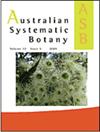Taxonomy of the Australian Nicotiana benthamiana complex (Nicotiana section Suaveolentes; Solanaceae): five species, four newly described, with distinct ranges and morphologies
IF 1.6
3区 生物学
Q4 EVOLUTIONARY BIOLOGY
引用次数: 3
Abstract
ABSTRACT Although some authors previously questioned the circumscription of Nicotiana benthamiana, it has never been treated taxonomically as more than a single widespread, variable species. A recent study employing phylogenetic and population genetic analyses has demonstrated that N. benthamiana comprises five species that are geographically and morphologically distinct. Here, we describe four new species in the N. benthamiana complex, namely, N. bilybara M.W.Chase & Christenh., N. candelabra M.W.Chase & Christenh., N. rupestris M.W.Chase & Christenh. and N. scopulorum M.W.Chase & Christenh., and illustrate all five. We provide descriptions, a diagnostic key and a table of morphological characters distinguishing these closely related species. The major morphological feature that distinguishes N. benthamiana from the other four species is its petiolate leaves that become sessile only near the apex of the inflorescence; N. candelabra is distinct in its bifacial branching, N. bilybara in its commonly winged petiole with an auriculate base, N. rupestris in the leafy apices of its calyx lobes, and N. scopulorum is the least morphologically divergent species, conforming most closely to the general description of the N. benthamiana species complex.澳大利亚烟属benthamiana复合体(Nicotiana section Suaveolentes)的分类;茄科):五种,四种新描述,具有不同的范围和形态
虽然一些作者以前质疑本烟属的界限,但它从未在分类学上被视为不止一种广泛分布的可变物种。最近一项采用系统发育和种群遗传分析的研究表明,benthamiana由地理上和形态上不同的五个物种组成。在这里,我们描述了四个新物种在N. benthamiana复合体,即N. bilybara M.W.Chase & Christenh。m.w.蔡斯&克里斯登。N. rupestris M.W.Chase & Christenh。N. scopulorum M.W.Chase & Christenh。,并举例说明这五个方面。我们提供了描述,诊断关键字和形态学特征表区分这些密切相关的物种。benthamiana与其他四种植物的主要形态学特征是它的叶柄只有在花序顶端附近才变成无柄;烛台奈米在其双面分支上是独特的,胆bara在其通常有翅的叶柄上有耳状基部,rupestris在其花萼裂片的叶尖上,而scopulorum是形态上分歧最小的物种,最接近于benthamiana物种复合体的一般描述。
本文章由计算机程序翻译,如有差异,请以英文原文为准。
求助全文
约1分钟内获得全文
求助全文
来源期刊

Australian Systematic Botany
生物-进化生物学
CiteScore
3.10
自引率
12.50%
发文量
12
审稿时长
>12 weeks
期刊介绍:
Australian Systematic Botany is an international journal devoted to the systematics, taxonomy, and related aspects of biogeography and evolution of all algae, fungi and plants, including fossils. Descriptive taxonomic papers should normally constitute a comprehensive treatment of a group. Short papers on individual species and nomenclatural papers must contain significant new information of broader interest to be considered. The prestigious L.A.S. Johnson Review Series is published. Other review articles will also be considered. All papers are peer reviewed.
Australian Systematic Botany is published with the endorsement of the Commonwealth Scientific and Industrial Research Organisation (CSIRO) and the Australian Academy of Science.
 求助内容:
求助内容: 应助结果提醒方式:
应助结果提醒方式:


